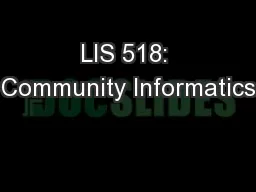PPT-Social Work Education and Technology: Challenges and Opport
Author : conchita-marotz | Published Date : 2015-11-18
Graduate School of Social Work University of Denver James Herbert Williams April 10 2010 Faculty Leaders Jean East Walter LaMendola Catherine Alter Julie Laser John
Presentation Embed Code
Download Presentation
Download Presentation The PPT/PDF document "Social Work Education and Technology: Ch..." is the property of its rightful owner. Permission is granted to download and print the materials on this website for personal, non-commercial use only, and to display it on your personal computer provided you do not modify the materials and that you retain all copyright notices contained in the materials. By downloading content from our website, you accept the terms of this agreement.
Social Work Education and Technology: Challenges and Opport: Transcript
Download Rules Of Document
"Social Work Education and Technology: Challenges and Opport"The content belongs to its owner. You may download and print it for personal use, without modification, and keep all copyright notices. By downloading, you agree to these terms.
Related Documents














